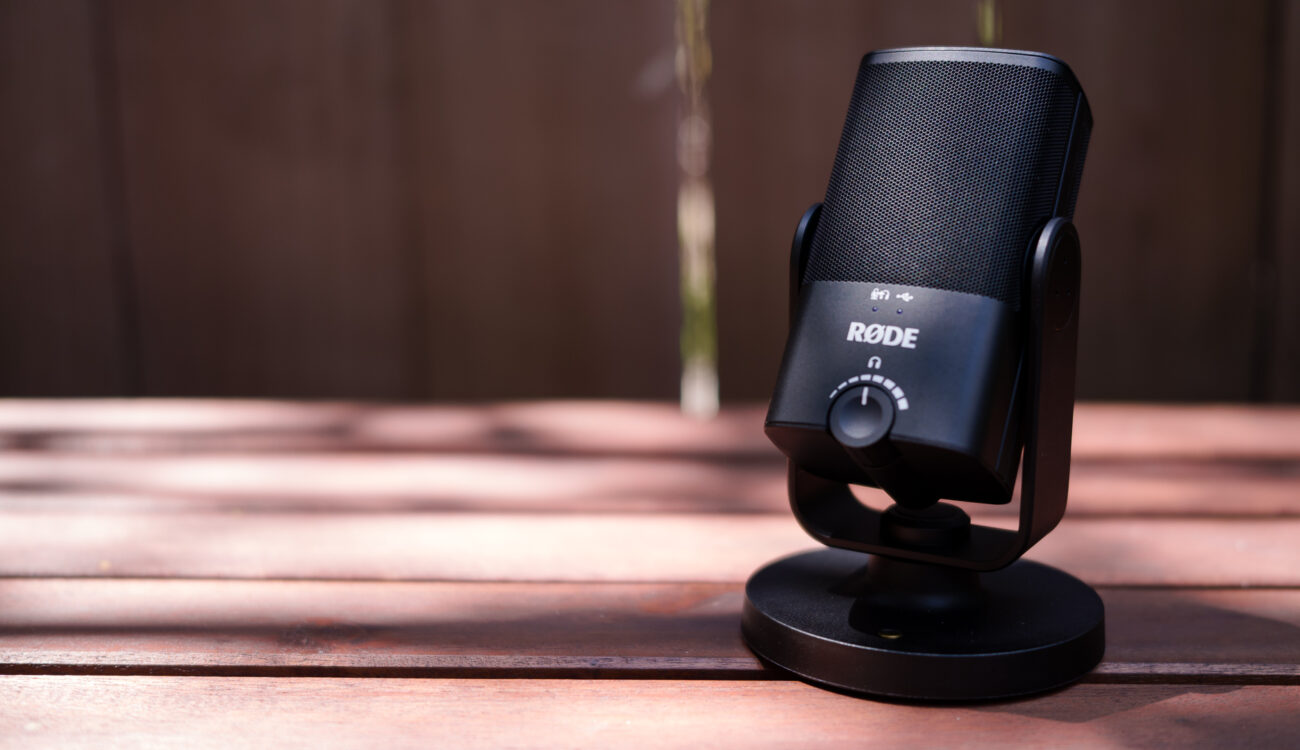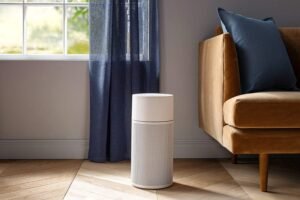
This is the review of the comparison between two microphones from two different popular brands. The comparison here is between the Blue Yeti Nano and the Rode NT-USB-Mini. These microphones are retailing for the same price of around a hundred and dollars currently but there are differences in their features and performances. To know which one is good for you to buy, go to the detailed review.
 |  |
| Blue Yeti Nano | Rode NT-USB-Mini |
| BUY NOW | BUY NOW |
| PROS | PROS |
| Two capsules provide cardioid or omnidirectional polar patterns. Excellent broadcast sound quality. Illuminated control dial. Plug and play – no installation. Headphone jack with low-latency monitoring. | Integrated interface and monitoring. Portable form-factor. Built-in pop shield. Great sound. |
| CONS | CONS |
| Gain is only adjustable via Sherpa software. Only two polar patterns. No multi-head setup. No pop filter or windscreen. | The included stand is quite short. No low-cut filter. No shock-mounting option. |
SPECIFICATIONS:
| HEADER | BLUE YETI NANO | RODE NT-USB-MINI |
| Brand | Blue Microphones | Rode |
| Product Line | Blue Microphones Yeti | NT-USB |
| Model | Nano | Mini |
| GENERAL | BLUE YETI NANO | RODE NT-USB-MINI |
| Manufacturer | Logitech | Rode |
| Recommended Use | computer | |
| MICROPHONE | BLUE YETI NANO | RODE NT-USB-MINI |
| Microphone Technology | electret condenser | electret condenser |
| Microphone Operation Mode | cardioid | |
| Sensitivity | -37 dB | |
| Microphone Power Source Voultage (DC) | ||
| Frequency Response | 20 Hz | 20 Hz-20 kHz |
| Signal-To-Noise Ratio | ||
| Total Harmonic Distortion (THD) | ||
| Max Sound Pressure | 110 db | |
| Audio Input Details | cardioid – 20 – 20000 Hz | |
| Connectivity Technology | Wired | Wired |
| AUDIO SYSTEM | BLUE YETI NANO | RODE NT-USB-MINI |
| Type | Microphone | Microphone |
| Recommended Use | computer | |
| Specific Applications | broadcast, recording | |
| Additional Functions | ||
| Controls | ||
| DIMENSIONS & WEIGHT | BLUE YETI NANO | RODE NT-USB-MINI |
| Component | ||
| Width | 3.8 in | 2.15 in |
| Depth | 4.3 in | 3.52 in |
| Height | 8.3 in | 5.59 in |
| Weight | 22.22 oz | 20.64 oz |
| FEATURES | BLUE YETI NANO | RODE NT-USB-MINI |
| Features | Perfect for vocals, musical instruments, podcasting / Podcasts, voiceovers, interviews, field recordings, conference calls, streaming, gaming, and gaming commentary. No-latency headphone output, headphone volume and mic mute. Standard threading for radius III shock mount and/or compass boom arm. Plug’N play Mac and PC compatible.. Cardioid and Omni pickup patterns; supports sample rates up to 24-bit / 48 KHz. | High-quality condenser capsule that delivers warmth and presence for a clear, professional sound. Directional cardioid pickup pattern optimised to reduce room sound and other extraneous noise. Smooth frequency response that sounds incredible in a wide variety of applications. In-built pop filter for reducing plosives. Unique detachable magnetic desk stand to mitigate knocks and bumps and is easy to remove. Integrated 360-degree swing mount for quick and easy positioning on a desktop, mic stand, or studio arm. |
Detail Review:
INTRODUCTION:
Blue Yeti Nano
The Blue Yeti Nano desktop condenser microphone is a small brother to the original Yeti. The Blue Yeti Nano is a small USB microphone and the first one that the company Blue has actually released since the announcement that they were being bought by Logitech. This is a $99 microphone which is only about 30 dollars cheaper than the average not sale price of the full-size Blue Yeti.
Rode NT-USB-Mini
The Rode NT-USB-Mini is retailing for around a hundred dollars. This is definitely along with the budget-friendly side microphones in the market. This microphone comes with only one polar pattern which is cardioid. Instead of keeping many polar patterns, they have focused more on one, which performs really well.

DESIGN:
Blue Yeti Nano
On the back of the microphone, there is an LED indicator for which pickup pattern mode in as well as a switch to switch between the two modes that it has. Cardioid which is meant for voiceover, most streaming, and YouTube related recording situations, and then the omnidirectional mode which picks up everything around the microphone and is more for recording as a group conversation in a conference call things like that where you have people all over the place, that you need to pick up as much as you can.
Over on the front of the microphone, you have a mute switch that mutes the mic, and then it has a green indicator for when you have monitoring enabled on the microphone. So, whether or not you can hear it in the headphone output, a volume adjustment for that and then you can actually hold this button on the back and switch off the monitoring if you just want to use it as a sound card. Then on the bottom of the mic, you have a standard 3.5-millimeter headphone jack and the port for your micro USB connection.
The stand on this is also nano-sized and completely useless for most applications because to get the best possible audio out of this microphone, you need to have a long stand attached to it. As it is short, it will pick up the noise of your keyboard, table, and all easily if you keep it on your desk.
Rode NT-USB-Mini
As far as the build quality it feels pretty good, I think it has a metal and nylon body, and the grille has quite a bit of giving to it, but it bounces right back without denting. The mount of the microphone that is attached to the microphone is made out of metal, and it allows for 360-degree rotation. On the front of the microphone, the first thing you’ll find is two lights first one being a zero-latency monitoring indicator light to let you know if that is on or off, and then you’ll find a USB connection light to let you know if it’s receiving power and is successfully connected to your computer. Then beneath that, you’ll find a volume dial that only controls the 3.5-millimeter output on the rear of the microphone. But it also doubles as a button to turn on or off the zero-latency monitoring.
Then on the back of the mic, you’ll find a 3.5-millimeter headphone output, which does allow for zero-latency monitoring as well as computer playback, and you can have both of these playings at the same time. Then you’ll find a USB-C port to connect this to your device. When we look at the mounting system, you are able to magnetically connect to the desktop stand but if you want to mount this to a boom arm, you’ll need to pop out the little rubber bit underneath the mic there, and then you’ll find 5/8 inch threading or you can throw in the 5/8 to 3/8 inch adapter to put this on a boom arm.

FEATURES:
Blue Yeti Nano
In the Box, you get the microphone itself pre-attached to the stand it just attaches via the two screws to the side, then it comes with an adapter to go from the quarter twenties 1/2 that’s actually on the microphone itself if you want to put it on on a normal tripod it should fit up to. Then it also comes with a fairly long micro-USB cable though if you’re trying to do something behind your monitor or mic arm runs or something, you may need a longer cable and that could cause some problems with USB stall out.
My favorite thing about this microphone release is the color options, this comes in a variety of different colors this is the red onyx version, shadow gray, Cubano gold, blackout, and vivid blue. The vivid blue and the red onyx look really great. For 99 dollars, it is a fairly high-quality microphone. I do have a couple of issues with it, they do include their own software to manage the levels and update the firmware. The software reflects which polar pattern you’re in, it shows your mic gain and can help you adjust that. Then you can adjust your playback level which is just reflected in Windows as an audio control panel.
It looks very similar, still has the same similar design, same similar stand just a lot smaller, and the stand is ridiculously small to the extent that no one should really be able to use this in a normal game streaming, or even podcasting set-up that’s the same issue with the Blue Snowball as most people want to set them on the desktop stand, which picks up all your keyboard, booms, and mouse clicks and things like that.
Unfortunately, it has a sound card the DAC is there. This is the whole issue with USB microphones as you can only fit so much in a small form-factor, and without sacrificing too much quality. So, the DAC isn’t so great, it doesn’t do a good job of powering mic higher-end headphones, so I didn’t like it. I believe that you’re expected to control the volume for the actual computer system sound to the microphone via Windows, and then the dial adjusts just the monitoring quality of the mic quality but also the level of the microphone.
Rode NT-USB-Mini
In the box, you are going to get the microphone, it comes with a previously installed mount, the desktop stand, a 5/8 to 3/8 inch microphone stand adapter, a USB-C to USB-A cable, and a QuickStart guide. As far as the specs, this microphone has a cardioid polar pattern, a frequency response of 20 Hertz to 20 kilohertz, a max SPL of 121 DBA, a bit depth of 24-bit, sample rate of 48 kilohertz, and as far as the headphone amp goes I was able to drive the HD 650’s although the volume was near 100%.
The NT-USB-Mini only has a single sample rate of 48 kilohertz, and with an i/o buffer size of 64 samples, we have a round-trip latency of nine milliseconds or four and 1/2 milliseconds output, when we jump up to 128 samples, we have 11 and 1/2 milliseconds round-trip or five-point seven milliseconds output, and when we jump up to 256 samples, we have 17 milliseconds round-trip or 8 and 1/2 milliseconds output.
At $100, I think this is a very interesting competitor in the USB condenser microphone market. This microphone is a USB class-compliant, so you will be able to use it with Windows, or Mac, or even a tablet as long as you can plug it into that device. I’m also happy to see that they included zero-latency monitoring in this microphone, the headphone amp was also capable of driving even the HD 650’s, which are very difficult to drive. I am also so happy that they did not put a bunch of different capsules and polar patterns in this microphone, and they really focused on a single capsule and a single polar pattern and focused on making that sound as good as they could.
I do find the noise floor of this microphone to be a little bit higher than I would typically want. I also would have liked to have seen a mixed dial to mix between zero-latency monitoring and computer playback. I would also like to have seen a longer USB cable to make it easier to mic up instruments and stuff that isn’t directly at your desk.
I think you need to buy a boom arm with this microphone because the provided desktop stand simply puts the microphone too far away from your mouth, and it picks up far too much room tone, and if you’re typing or gaming, or if you’re somebody who bumps the desk a lot, the microphone will pick up all of that if you’re using the provided desktop stand and attaching it on a boom arm will get you much better sound.

PERFORMANCE:
Blue Yeti Nano
This microphone sounds the best, actually, most of them sound pretty good for USB microphones when they’re in the cardioid pickup pattern mode and up next to your face because otherwise, they start picking up a lot of weird noise. As far as the sound quality and performance of this microphone, by my testing, it sounds fairly good.
It actually sounds fairly competent, fairly good but if I put it into the situation where your mic will be far away from your face, you’re going to get reflections off the monitor, it will be picking up the room noise, and it’s not going to sound good. If you start typing in your game or playing a game and it doesn’t sound great. But when you bring it closer to your mouth, you actually talked into the front side of this microphone right there, because it sounds great from there.
Rode NT-USB-Mini
On the electric guitar, I really wasn’t that impressed because, in the higher frequencies, it started to get a little bit trill and grading and just unpleasant to listen to. So, for an electric guitar, it would not be my first choice and it’s not something I would reach for very often. Then on the acoustic guitar, it offers a very mid-forward sound with a good amount of articulation, without sounding brittle or harsh, and I would be perfectly happy using this microphone to record some acoustic guitar for a YouTube video, or for some music demos.
For singing, I think that’s my favorite application for this microphone, it just offers an incredibly smooth midsection, and then in the treble and air frequencies there’s this really nice to it without sounding brittle, and in the lower frequencies it is still there but it’s not overpowering, and it doesn’t sound too thin. Lastly for spoken word, the main thing about this microphone is that it is very mid-forward, and it does tend to accentuate some of those nasal frequencies, so if you have a nasal voice this may not be your best. Also, if you are just looking for that modern v-shaped sound with a lot of basses and a lot of trebles, and somewhat of a recessed midsection, this microphone is not going to offer it for you.

WHICH TO BUY?
If your max budget is $100 and you are set on a USB condenser microphone, I think the Rode NT-USB-Mini sounds really good, and I like the fact that it offers a different tonality, compared to Blue Yeti Nano it offers a very different much more mid-forward sound. So, if that is your budget and that’s the type of microphone you’re looking for, and you like the mid-forward sound, then the Rode NT-USB-Mini is really good for to buy.
Expert Reviews of Blue Yeti Nano:
By PCMag
The reasonably priced Blue Yeti Nano USB microphone delivers high-quality, crisp audio with two selectable polar patterns and a DSP-free signal chain.By Laptop Mag
The Blue Yeti Nano combines excellent sound quality and easy setup with a lightweight, premium design.By Tom’s Hardware
At the expense of a couple of extra polar patterns, the Blue Yeti Nano is a fantastic way to get that clean, refined Yeti sound for less than other mics in the lineup.By Tech Radar
The Blue Yeti is a great option for anyone who just wants to plug in and play without spending hours tweaking audio settings.By IGN
Blue continues its dominance of the USB podcasting mic space with the Yeti Nano. The smaller size is generally a bonus, and while there are a few features missing due to its shrinkage, the sound quality…Expert Reviews of Rode NT-USB-Mini:
By music radar
Great features combine with a compact stylish design and attractive price to make NT-USB Mini a highly desirable USB mic.By Richard tech
If you’re looking for a compact microphone that can offer a fantastic quality sound for the price, the Rode NT-USB Mini is a fantastic option. It is great not only for voiceovers and recording…By camaralab.com
The Rode NT USB Mini is a compact USB microphone designed for gamers, podcasters, musicians, streamers, or voiceovers. Announced in February 2020, it’s a smaller and more affordable alternative to the original Rode NT USB from 2014, a microphone…By PCMag
The NT-USB Mini is a crisp, clear USB mic microphone. Some of the frills it lacks—DSP, for instance—may appeal to those seeking a pure signal path, while others—like the lack of a gain knob—are a bit less easy to get excited about. In this general…By IGN
Rode’s NT-USB Mini sounds surprisingly great. For a $100 mic that you can virtually enclose entirely in your hand by making a fist, it sounds excellent, with a great frequency response…




